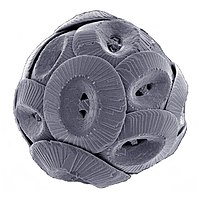
Photo from wikipedia
Abstract Hydroxyapatite (HAp) with hollow structure was successfully synthesized by hydrothermal process of as-prepared calcium carbonate used as a hard template and calcium sources in a diammonium phosphate solution. Calcium… Click to show full abstract
Abstract Hydroxyapatite (HAp) with hollow structure was successfully synthesized by hydrothermal process of as-prepared calcium carbonate used as a hard template and calcium sources in a diammonium phosphate solution. Calcium carbonate was fabricated by precipitation, which possessed different morphologies such as balls, rods and blocks through regulating the amount of citric acid. The synthesized powders were characterized by X-ray diffraction (XRD), Fourier transform infrared spectrograph (FT-IR), field-emission scanning electron microscope (FESEM) and high-resolution transmission electron microscopy (HRTEM) and nitrogen adsorption–desorption. Results indicated that different morphologies calcium carbonate could convert to hollow structural HAp with the higher BET surface area and the mesopores. Hydrothermal temperature and hydrothermal time play a slight role on transition percentage. As hydrothermal temperature and hydrothermal time increased, the conversion rate of calcium carbonate to hydroxyapatite increased. The possible formation mechanism of hydroxyapatite was preliminarily investigated. The resultants of HAp are interesting materials for drug delivery and sustained-release.
Journal Title: Advanced Powder Technology
Year Published: 2018
Link to full text (if available)
Share on Social Media: Sign Up to like & get
recommendations!